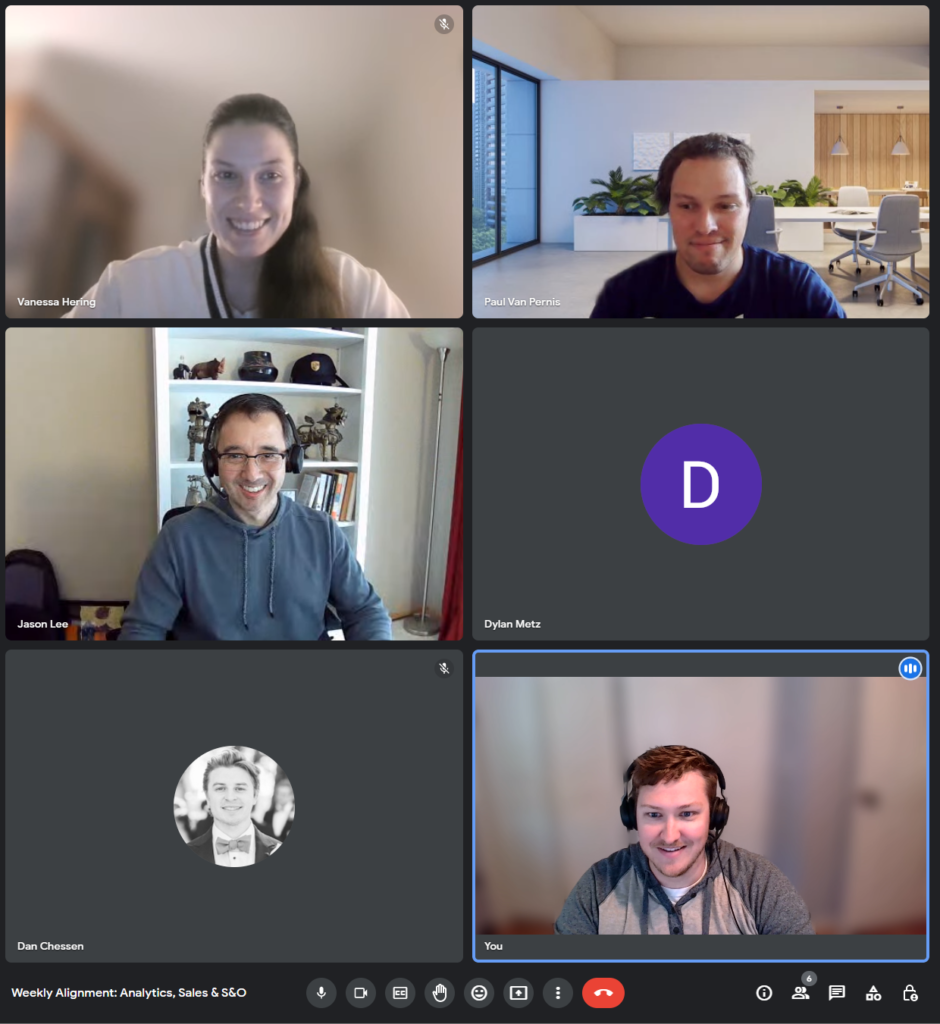We chatted with our Director of Sales Analytics Paul Rasmussen, to learn more about his day-to-day, the team dynamic he has built and his favorite parts about working at Beyond Finance.
How long have you been on the team, and what do you do?
I’ve been with Beyond for about a year and a half. Initially, I was a Senior Sales Manager and now have the role of Director of Sales Analytics for the Business Analytics Team.
How did you first get interested in sales and analytics?
My background in finance is nontraditional. I started selling sunglasses on eBay in high school, eventually founding a start-up business selling coin-collecting supplies. This led to me running a company during undergrad and for a few years after graduation. I then pivoted full-time into a few finance and asset management positions, which evolved into pursuing my MBA. Post-MBA, I entered a rotational program at a large bank, where I did stints in internal consulting, strategic analytics and incident management. These combined experiences gave me a robust understanding of what it takes to keep a business running and helped shape me into a better leader.
What’s your team dynamic?
The incredible thing about my team is that we are small in size but mighty in talent! With us being a smaller team, I ensure everyone has all the tools needed to succeed. I put great emphasis on individual development and being available to them if they have any questions. The ability to dive deep and understand analytics is essential, but taking your 50-tab Excel spreadsheet and turning it into a few bullet points or concise thoughts is equally important. Helping my team master both skill sets is vitally important and a big part of my role.
Could you break down your day-to-day at Beyond — perhaps using a typical Monday as an example?
9:00 a.m.
By this time, I have seen my kids off to school, and I come in to check Slack messages. Slack is big here at Beyond. We use it to communicate with our team regularly and if something significant is coming or I want quick company news, it’s probably already posted there.
9:15 a.m.
I spend this time going through emails to ensure there are no time-sensitive or urgent issues. I also review my team’s current projects and determine how they align with our weekly tasks. This gives me time to review all different aspects of the business to ensure we prioritize correctly and the dates line up cohesively.
10:00 a.m.
Usually, I have meetings with any number of people at this time. This particular Monday, it was with Ashwin Ganesan, Senior Vice President of Strategy and Operations, and the rest of the department to update them on the progress of last week’s projects. We cover things like commission overview, sales agent performance and date updates for Strategy and Operations.
They have their priority list, and we have ours. So ensuring they align can be vital to staying on track.
11:00 a.m.
On Mondays, 11 a.m. is generally open for me. My team is based on the West Coast, so I use the time to catch up on emails, Slack messages and plan for the week ahead. That’s not to say it’s always wide open. I usually get the impromptu request to discuss an analytics project from one of our stakeholders. I might be added to a call to give a quick read on how agent commissions are trending for the month or prep for an afternoon meeting.
12:00 p.m.
At this point I’m usually syncing up with the team to go more in depth with their current projects. If it requires a one-on-one, it can be scheduled during this time.
I usually take a later lunch during a slow time because I live on the East Coast. Mondays are packed with meetings later in the day.
1:00 p.m.

The weekly Affiliate Performance meeting happens every Monday. The point of this meeting is to review affiliate partners’ performance and align with internal stakeholders on decisions surrounding optimizing, scaling or cutting affiliate lead sources. Essentially, affiliate performance is evaluated on how well their leads convert into clients and how well those clients perform — for example, are new clients making deposits into their Dedicated Account?
The decisions to add or remove lead volume are not solely based on affiliate performance and analytics. Our team must come to the meeting with a firm understanding of staffing levels for the coming weeks and how many leads we can realistically handle. That understanding then feeds into the conversation of whether the business can support the additional lead flow or if additional lower-performing volume needs to experience a shift to hit our volume targets. We want to ensure our agents have the best leads to maximize their performance and total client adds.
3:00 p.m.
A few meetings generally happen between now and the end of the day. The first is a weekly project review between Business Intelligence (BI) and Analytics. From a data standpoint, BI ensures the lights stay on around here. They are critical to setting up the external data that feeds into our databases, refining it, and curating the logic so different business units get the reporting they need.
Understandably, different business areas are constantly vying for BI’s resources. These meetings are critical to understanding current projects, what’s in their backlog and any new projects folks want to add to the list. There can be a fair bit of reprioritization of projects from one week to the next so this meeting is vital to getting everyone on the same page and aligning for the coming week.
The second meeting is a Sales Analytics (SA) prioritization call, where the other team members and I who work in SA align on the week ahead. It’s similar to the BI call, but only for the SA team.
4:30 p.m.
Around this time, we hold a staffing meeting with executives to evaluate how our lead assumptions look relative to actual lead flow, if lead volumes are appropriate for current staffing levels, and if we have seen improvements or degradation of lead efficiency metrics. Essentially we discuss the components of staffing and occupancy, ensuring all the data is accurate. This meeting takes me to the end of the day.
How important is the staffing meeting with leadership to the rest of your week?
The Monday staffing call sets the tone for the rest of the week. The team discusses a range of items, from how lead performance is trending targets to how hourly targets for lead volume are coming in. We have a set agenda for this meeting but different problems are solved each week.
We are trying to answer the overarching questions: Will agent staffing levels for the coming week be appropriate to handle the lead volume? Is lead flow sufficient to ensure agents can hit their productivity targets? How is that lead flow performing? Are there new projects or initiatives analytics needs to be aware of?

How has the transition to fully remote work been?
It has been great not having to commute. Being able to spend mornings with my family has been a game-changer. It has helped establish a routine for us — having breakfast as a family and seeing them off before I start work. By the time they come home, my day has usually concluded and I can be fully present with them.
Do you have any other favorite things about being at Beyond?
The balance I have achieved here with work and personal life has been indescribable. Especially with a family, having time off and the necessary tools to achieve my goals at work is important.
Another great thing about Beyond is the room to grow. I started as a manager and realized I wanted to contribute more. I was willing to work hard to achieve a higher leadership position. At Beyond, if you want something and speak up, they will give you the opportunity.
